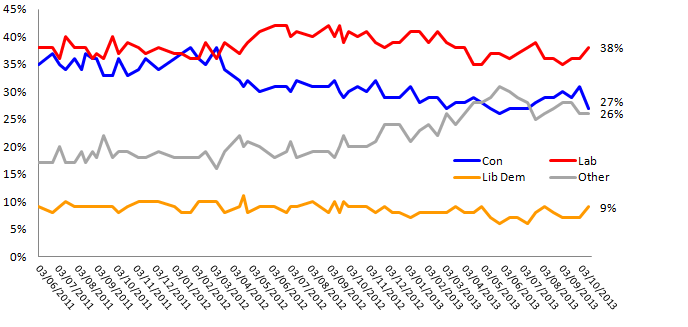Political Polling – 15th October 2013
15th October 2013
Labour’s lead has opened up again to 11 points after dropping to 5 in the previous poll.
Ed Miliband’s party has 38% of the hypothetical vote compared to just 27% for the Conservatives, 9% for the Lib Dems and 17% for UKIP.


| † | % | Change |
| Conservative | 27 | -4 |
| Labour | 38 | +2 |
| Liberal Democrats | 9 | +2 |
| Other parties | 26 | n/c |
Other Parties (breakdown)
| † | % | Change |
| UKIP | 17 | +2 |
| Green | 4 | n/c |
| SNP | 3 | -1 |
| BNP | 0 | -2 |
| Plaid Cymru | 1 | +1 |
| Other | 0 | -1 |
Approval ratings
- David Cameron’s net approval rating has returned to -18%, erasing any post-conference “bounce” he enjoyed. 33% approve of his job performance while 51% disapprove
- Ed Miliband’s ratings have remained consistent with the last poll. 25% approve while 44% disapprove giving him a net rating of -19%, just behind David Cameron and two points above his net rating in the last poll
- Lib Dem leader Nick Clegg remains at -43% net approval with 16% approving and 59% disapproving
| † | % Approve | % Disapprove | Net rating | Net rating (own party) |
| David Cameron | 33% | 51% | -18% | +81% |
| Ed Miliband | 25% | 44% | -19% | +46% |
| Nick Clegg | 16% | 59% | -43% | +49% |
Opinium Research carried out an online survey of 1,936 GB adults aged 18+ from 15th to 18th October 2013. Results have been weighted to nationally representative criteria.
Interview Method and Sample
This survey is conducted online by CAWI (computer aided web interviewing), using Opinium?s online research panel of circa 30,000 individuals. This research is run from a representative sample of GB adults (aged 18+ in England, Scotland and Wales). The sample is defined from pre-collected registration data containing gender, age (18-34, 35-54, and 55+), region (North East, North West, Yorkshire and Humberside, East Midlands, West Midlands, East of England, London, South East, South West, Wales, and Scotland), working status and social grade to match the latest published ONS figures.
Opinium also takes into account differential response rates from the different demographic groups, to ensure the sample is representative.


